Abstract
The cytochrome bd complex is a ubiquinol oxidase, which is part of the aerobic respiratory chain of Escherichia coli. This enzyme is structurally unrelated to the heme-Cu oxidases such as cytochrome c oxidase. While the cytochrome bd complex contains no copper, it does have three heme prosthetic groups: heme b558, heme b595, and heme d (a chlorin). Heme b558 appears to be involved in the oxidation of quinol, and heme d is known to be the site where oxygen binds and is reduced to water. The role of heme b595, which is high spin, is not known. In this paper, CO is used to probe the oxygen-binding site by use of Fourier transform infrared spectroscopy to monitor the stretching frequency of CO bound to the enzyme. Photodissociation at low temperature (e.g., 20 K) of the CO-heme d adduct results in CO associated with the protein within the heme binding pocket. This photodissociated CO can subsequently relax to form a kinetically trapped CO-heme b595 adduct. The data clearly show that heme d and heme b595 must reside within a common binding pocket in the enzyme. The catalytic active site where oxygen is reduced to water is, thus, properly considered to be a heme d-heme b595 binuclear center. This is analogous to the heme alpha 3-Cu(B) binuclear center in the heme-Cu oxidases. Heme b595 may play roles analogous to those proposed for the Cu(B) component of cytochrome c oxidase.
Full text
PDF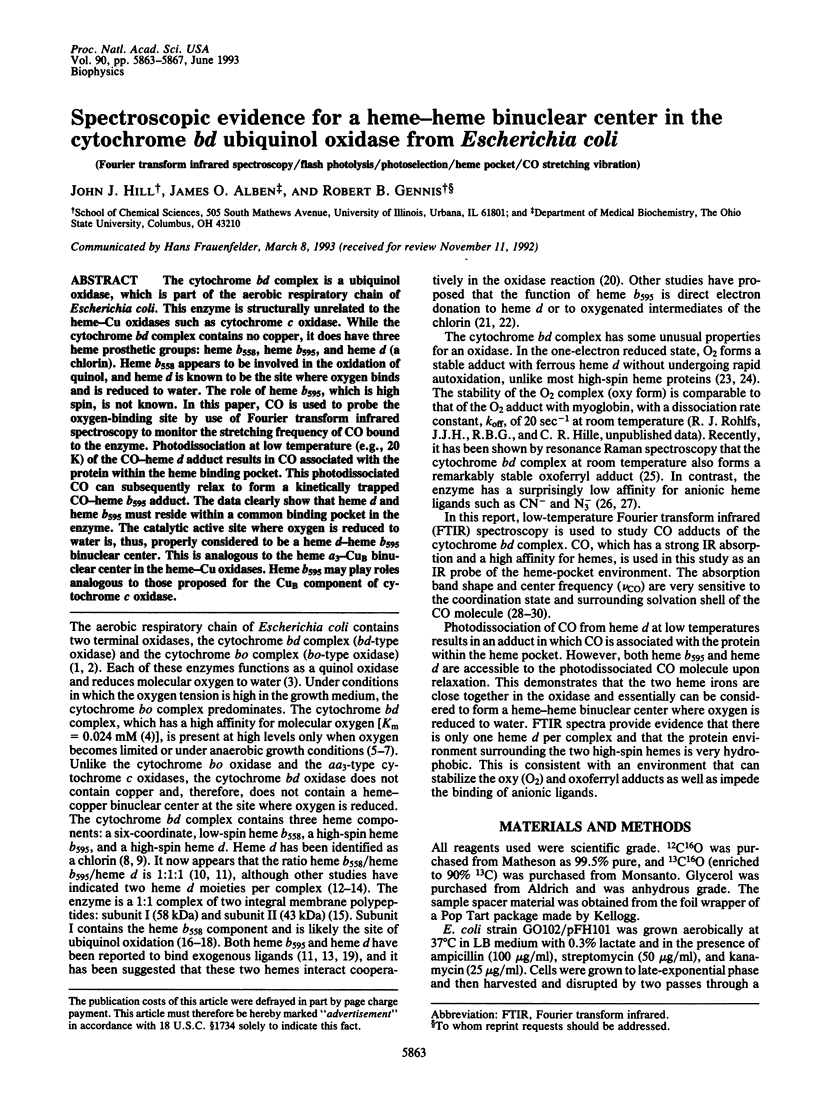
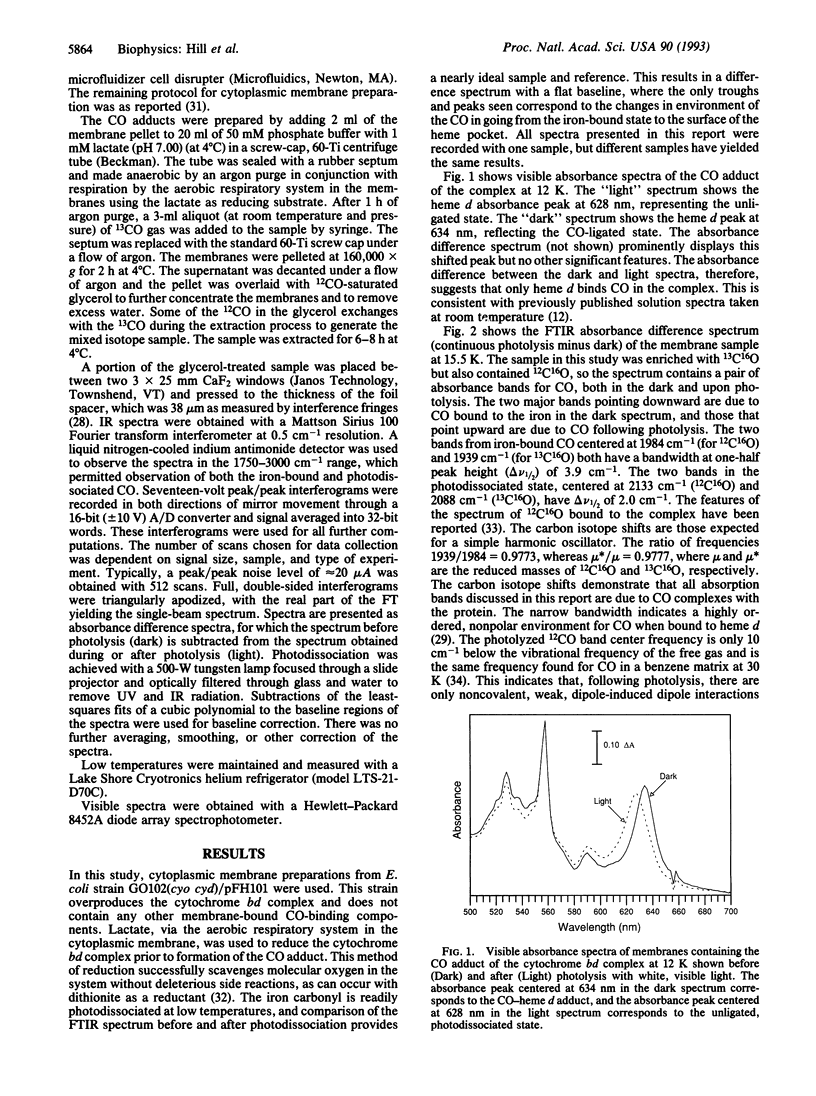
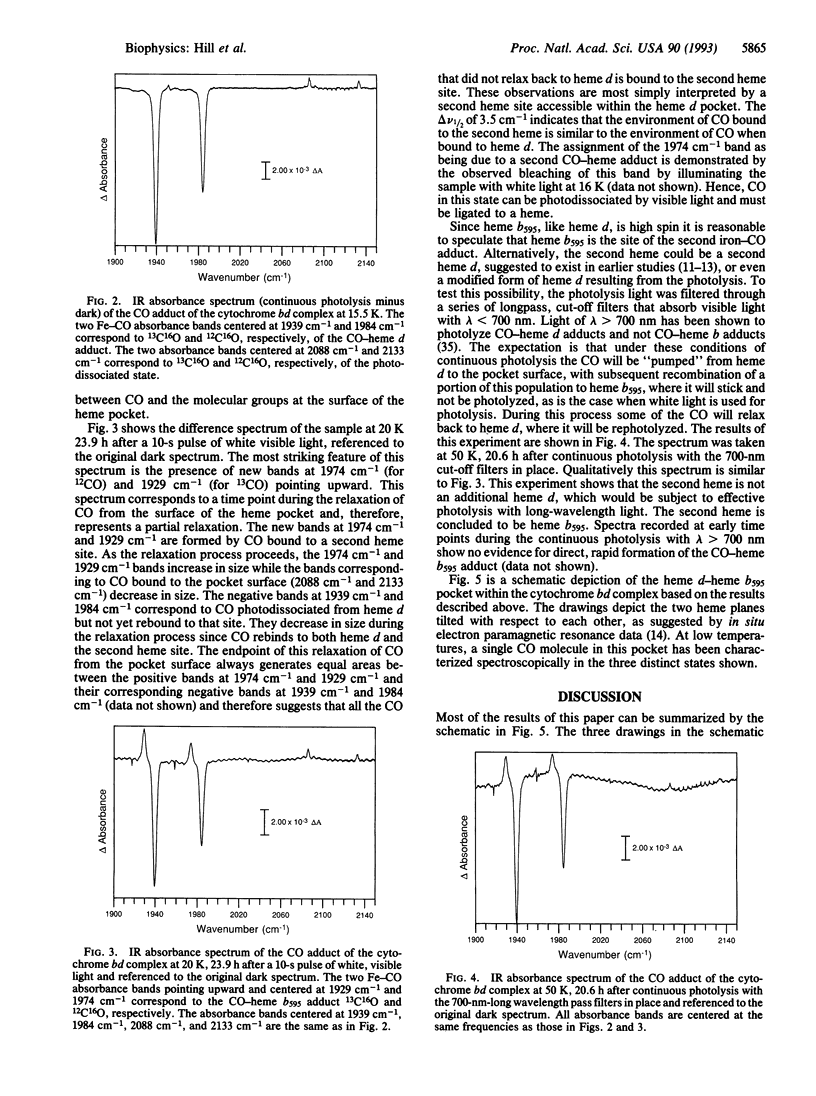
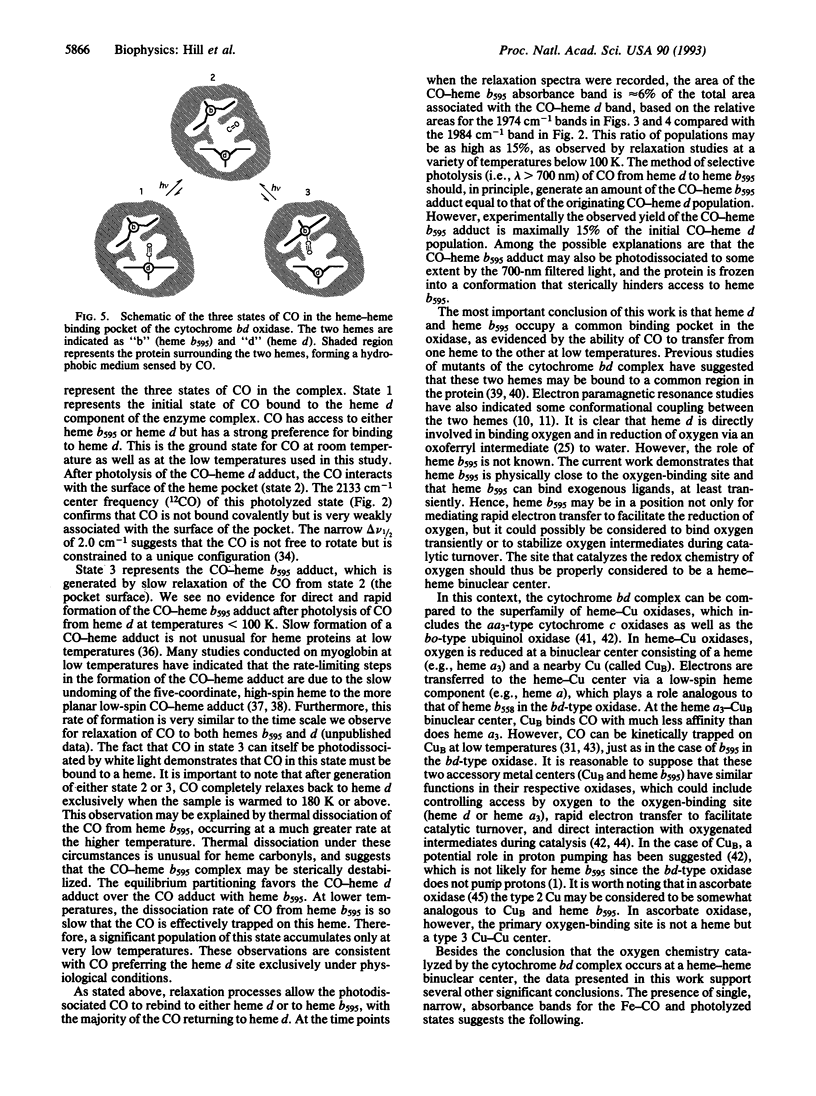
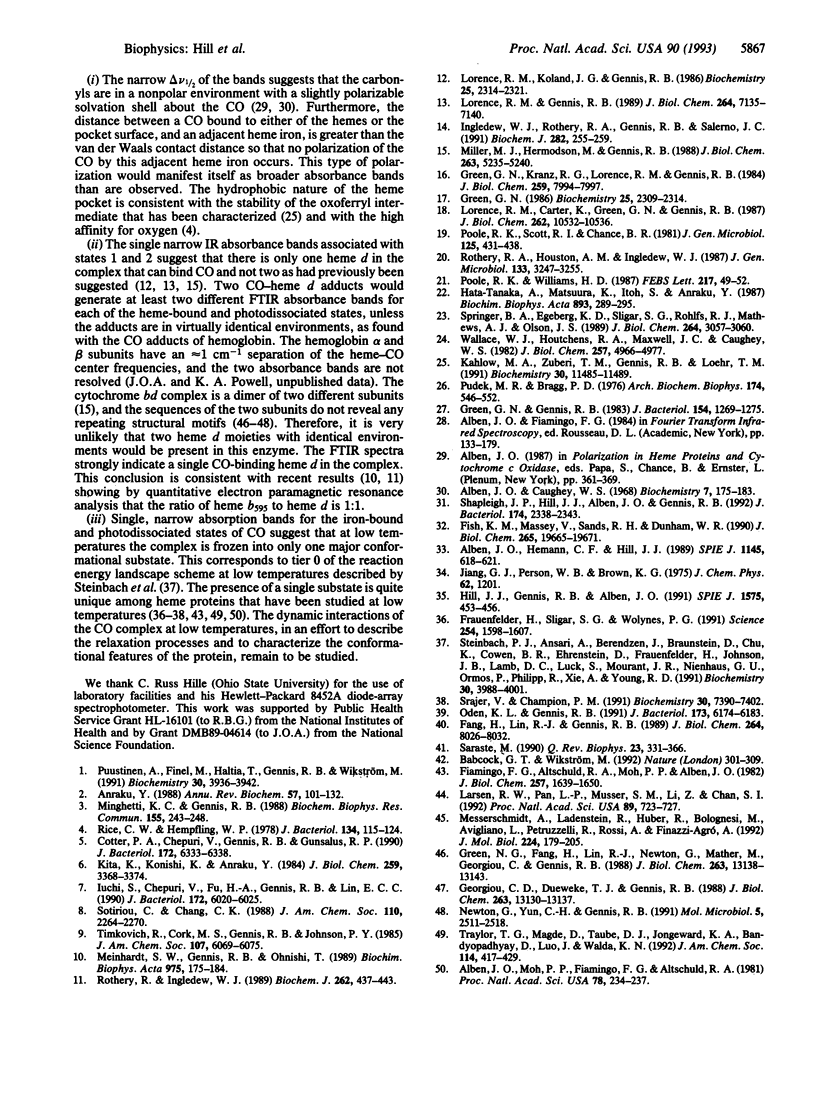
Images in this article
Selected References
These references are in PubMed. This may not be the complete list of references from this article.
- Alben J. O., Caughey W. S. An infrared study of bound carbon monoxide in the human red blood cell, isolated hemoglobin, and heme carbonyls. Biochemistry. 1968 Jan;7(1):175–183. doi: 10.1021/bi00841a022. [DOI] [PubMed] [Google Scholar]
- Alben J. O., Moh P. P., Fiamingo F. G., Altschuld R. A. Cytochrome oxidase (a3) heme and copper observed by low-temperature Fourier transform infrared spectroscopy of the CO complex. Proc Natl Acad Sci U S A. 1981 Jan;78(1):234–237. doi: 10.1073/pnas.78.1.234. [DOI] [PMC free article] [PubMed] [Google Scholar]
- Anraku Y. Bacterial electron transport chains. Annu Rev Biochem. 1988;57:101–132. doi: 10.1146/annurev.bi.57.070188.000533. [DOI] [PubMed] [Google Scholar]
- Babcock G. T., Wikström M. Oxygen activation and the conservation of energy in cell respiration. Nature. 1992 Mar 26;356(6367):301–309. doi: 10.1038/356301a0. [DOI] [PubMed] [Google Scholar]
- Cotter P. A., Chepuri V., Gennis R. B., Gunsalus R. P. Cytochrome o (cyoABCDE) and d (cydAB) oxidase gene expression in Escherichia coli is regulated by oxygen, pH, and the fnr gene product. J Bacteriol. 1990 Nov;172(11):6333–6338. doi: 10.1128/jb.172.11.6333-6338.1990. [DOI] [PMC free article] [PubMed] [Google Scholar]
- Fang H., Lin R. J., Gennis R. B. Location of heme axial ligands in the cytochrome d terminal oxidase complex of Escherichia coli determined by site-directed mutagenesis. J Biol Chem. 1989 May 15;264(14):8026–8032. [PubMed] [Google Scholar]
- Fiamingo F. G., Altschuld R. A., Moh P. P., Alben J. O. Dynamic interactions of CO with a3Fe and CuB in cytochrome c oxidase in beef heart mitochondria studied by Fourier transform infrared spectroscopy at low temperatures. J Biol Chem. 1982 Feb 25;257(4):1639–1650. [PubMed] [Google Scholar]
- Fish K. M., Massey V., Sands R. H., Dunham W. R. The interaction of bisulfite with milk xanthine oxidase. J Biol Chem. 1990 Nov 15;265(32):19665–19671. [PubMed] [Google Scholar]
- Frauenfelder H., Sligar S. G., Wolynes P. G. The energy landscapes and motions of proteins. Science. 1991 Dec 13;254(5038):1598–1603. doi: 10.1126/science.1749933. [DOI] [PubMed] [Google Scholar]
- Georgiou C. D., Dueweke T. J., Gennis R. B. Beta-galactosidase gene fusions as probes for the cytoplasmic regions of subunits I and II of the membrane-bound cytochrome d terminal oxidase from Escherichia coli. J Biol Chem. 1988 Sep 15;263(26):13130–13137. [PubMed] [Google Scholar]
- Green G. N., Fang H., Lin R. J., Newton G., Mather M., Georgiou C. D., Gennis R. B. The nucleotide sequence of the cyd locus encoding the two subunits of the cytochrome d terminal oxidase complex of Escherichia coli. J Biol Chem. 1988 Sep 15;263(26):13138–13143. [PubMed] [Google Scholar]
- Green G. N., Gennis R. B. Isolation and characterization of an Escherichia coli mutant lacking cytochrome d terminal oxidase. J Bacteriol. 1983 Jun;154(3):1269–1275. doi: 10.1128/jb.154.3.1269-1275.1983. [DOI] [PMC free article] [PubMed] [Google Scholar]
- Green G. N., Kranz R. G., Lorence R. M., Gennis R. B. Identification of subunit I as the cytochrome b558 component of the cytochrome d terminal oxidase complex of Escherichia coli. J Biol Chem. 1984 Jun 25;259(12):7994–7997. [PubMed] [Google Scholar]
- Green G. N., Lorence R. M., Gennis R. B. Specific overproduction and purification of the cytochrome b558 component of the cytochrome d complex from Escherichia coli. Biochemistry. 1986 May 6;25(9):2309–2314. doi: 10.1021/bi00357a002. [DOI] [PubMed] [Google Scholar]
- Hata-Tanaka A., Matsuura K., Itoh S., Anraku Y. Electron flow and heme-heme interaction between cytochromes b-558, b-595 and d in a terminal oxidase of Escherichia coli. Biochim Biophys Acta. 1987 Sep 10;893(2):289–295. doi: 10.1016/0005-2728(87)90050-8. [DOI] [PubMed] [Google Scholar]
- Ingledew W. J., Rothery R. A., Gennis R. B., Salerno J. C. The orientation of the three haems of the 'in situ' ubiquinol oxidase, cytochrome bd, of Escherichia coli. Biochem J. 1992 Feb 15;282(Pt 1):255–259. doi: 10.1042/bj2820255. [DOI] [PMC free article] [PubMed] [Google Scholar]
- Iuchi S., Chepuri V., Fu H. A., Gennis R. B., Lin E. C. Requirement for terminal cytochromes in generation of the aerobic signal for the arc regulatory system in Escherichia coli: study utilizing deletions and lac fusions of cyo and cyd. J Bacteriol. 1990 Oct;172(10):6020–6025. doi: 10.1128/jb.172.10.6020-6025.1990. [DOI] [PMC free article] [PubMed] [Google Scholar]
- Kahlow M. A., Zuberi T. M., Gennis R. B., Loehr T. M. Identification of a ferryl intermediate of Escherichia coli cytochrome d terminal oxidase by resonance Raman spectroscopy. Biochemistry. 1991 Dec 10;30(49):11485–11489. doi: 10.1021/bi00113a001. [DOI] [PubMed] [Google Scholar]
- Kita K., Konishi K., Anraku Y. Terminal oxidases of Escherichia coli aerobic respiratory chain. I. Purification and properties of cytochrome b562-o complex from cells in the early exponential phase of aerobic growth. J Biol Chem. 1984 Mar 10;259(5):3368–3374. [PubMed] [Google Scholar]
- Larsen R. W., Pan L. P., Musser S. M., Li Z. Y., Chan S. I. Could CuB be the site of redox linkage in cytochrome c oxidase? Proc Natl Acad Sci U S A. 1992 Jan 15;89(2):723–727. doi: 10.1073/pnas.89.2.723. [DOI] [PMC free article] [PubMed] [Google Scholar]
- Lorence R. M., Carter K., Green G. N., Gennis R. B. Cytochrome b558 monitors the steady state redox state of the ubiquinone pool in the aerobic respiratory chain of Escherichia coli. J Biol Chem. 1987 Aug 5;262(22):10532–10536. [PubMed] [Google Scholar]
- Lorence R. M., Gennis R. B. Spectroscopic and quantitative analysis of the oxygenated and peroxy states of the purified cytochrome d complex of Escherichia coli. J Biol Chem. 1989 May 5;264(13):7135–7140. [PubMed] [Google Scholar]
- Lorence R. M., Koland J. G., Gennis R. B. Coulometric and spectroscopic analysis of the purified cytochrome d complex of Escherichia coli: evidence for the identification of "cytochrome a1" as cytochrome b595. Biochemistry. 1986 May 6;25(9):2314–2321. doi: 10.1021/bi00357a003. [DOI] [PubMed] [Google Scholar]
- Meinhardt S. W., Gennis R. B., Ohnishi T. EPR studies of the cytochrome-d complex of Escherichia coli. Biochim Biophys Acta. 1989 Jun 23;975(1):175–184. doi: 10.1016/s0005-2728(89)80216-6. [DOI] [PubMed] [Google Scholar]
- Messerschmidt A., Ladenstein R., Huber R., Bolognesi M., Avigliano L., Petruzzelli R., Rossi A., Finazzi-Agró A. Refined crystal structure of ascorbate oxidase at 1.9 A resolution. J Mol Biol. 1992 Mar 5;224(1):179–205. doi: 10.1016/0022-2836(92)90583-6. [DOI] [PubMed] [Google Scholar]
- Miller M. J., Hermodson M., Gennis R. B. The active form of the cytochrome d terminal oxidase complex of Escherichia coli is a heterodimer containing one copy of each of the two subunits. J Biol Chem. 1988 Apr 15;263(11):5235–5240. [PubMed] [Google Scholar]
- Minghetti K. C., Gennis R. B. The two terminal oxidases of the aerobic respiratory chain of Escherichia coli each yield water and not peroxide as a final product. Biochem Biophys Res Commun. 1988 Aug 30;155(1):243–248. doi: 10.1016/s0006-291x(88)81075-1. [DOI] [PubMed] [Google Scholar]
- Newton G., Yun C. H., Gennis R. B. Analysis of the topology of the cytochrome d terminal oxidase complex of Escherichia coli by alkaline phosphatase fusions. Mol Microbiol. 1991 Oct;5(10):2511–2518. doi: 10.1111/j.1365-2958.1991.tb02097.x. [DOI] [PubMed] [Google Scholar]
- Oden K. L., Gennis R. B. Isolation and characterization of a new class of cytochrome d terminal oxidase mutants of Escherichia coli. J Bacteriol. 1991 Oct;173(19):6174–6183. doi: 10.1128/jb.173.19.6174-6183.1991. [DOI] [PMC free article] [PubMed] [Google Scholar]
- Poole R. K., Scott R. I., Chance B. The light-reversible binding of carbon monoxide to cytochrome a1 in Escherichia coli K12. J Gen Microbiol. 1981 Aug;125(2):431–438. doi: 10.1099/00221287-125-2-431. [DOI] [PubMed] [Google Scholar]
- Poole R. K., Williams H. D. Proposal that the function of the membrane-bound cytochrome a1-like haemoprotein (cytochrome b-595) in Escherichia coli is a direct electron donation to cytochrome d. FEBS Lett. 1987 Jun 8;217(1):49–52. doi: 10.1016/0014-5793(87)81240-1. [DOI] [PubMed] [Google Scholar]
- Pudek M. R., Bragg P. D. Redox potentials of the cytochromes in the respiratory chain of aerobically grown Escherichia coli. Arch Biochem Biophys. 1976 Jun;174(2):546–552. doi: 10.1016/0003-9861(76)90382-9. [DOI] [PubMed] [Google Scholar]
- Puustinen A., Finel M., Haltia T., Gennis R. B., Wikström M. Properties of the two terminal oxidases of Escherichia coli. Biochemistry. 1991 Apr 23;30(16):3936–3942. doi: 10.1021/bi00230a019. [DOI] [PubMed] [Google Scholar]
- Rice C. W., Hempfling W. P. Oxygen-limited continuous culture and respiratory energy conservation in Escherichia coli. J Bacteriol. 1978 Apr;134(1):115–124. doi: 10.1128/jb.134.1.115-124.1978. [DOI] [PMC free article] [PubMed] [Google Scholar]
- Rothery R. A., Houston A. M., Ingledew W. J. The respiratory chain of anaerobically grown Escherichia coli: reactions with nitrite and oxygen. J Gen Microbiol. 1987 Nov;133(11):3247–3255. doi: 10.1099/00221287-133-11-3247. [DOI] [PubMed] [Google Scholar]
- Rothery R. A., Ingledew W. J. The cytochromes of anaerobically grown Escherichia coli. An electron-paramagnetic-resonance study of the cytochrome bd complex in situ. Biochem J. 1989 Jul 15;261(2):437–443. doi: 10.1042/bj2610437. [DOI] [PMC free article] [PubMed] [Google Scholar]
- Saraste M. Structural features of cytochrome oxidase. Q Rev Biophys. 1990 Nov;23(4):331–366. doi: 10.1017/s0033583500005588. [DOI] [PubMed] [Google Scholar]
- Shapleigh J. P., Hill J. J., Alben J. O., Gennis R. B. Spectroscopic and genetic evidence for two heme-Cu-containing oxidases in Rhodobacter sphaeroides. J Bacteriol. 1992 Apr;174(7):2338–2343. doi: 10.1128/jb.174.7.2338-2343.1992. [DOI] [PMC free article] [PubMed] [Google Scholar]
- Springer B. A., Egeberg K. D., Sligar S. G., Rohlfs R. J., Mathews A. J., Olson J. S. Discrimination between oxygen and carbon monoxide and inhibition of autooxidation by myoglobin. Site-directed mutagenesis of the distal histidine. J Biol Chem. 1989 Feb 25;264(6):3057–3060. [PubMed] [Google Scholar]
- Srajer V., Champion P. M. Investigations of optical line shapes and kinetic hole burning in myoglobin. Biochemistry. 1991 Jul 30;30(30):7390–7402. doi: 10.1021/bi00244a005. [DOI] [PubMed] [Google Scholar]
- Steinbach P. J., Ansari A., Berendzen J., Braunstein D., Chu K., Cowen B. R., Ehrenstein D., Frauenfelder H., Johnson J. B., Lamb D. C. Ligand binding to heme proteins: connection between dynamics and function. Biochemistry. 1991 Apr 23;30(16):3988–4001. doi: 10.1021/bi00230a026. [DOI] [PubMed] [Google Scholar]
- Wallace W. J., Houtchens R. A., Maxwell J. C., Caughey W. S. Mechanism of autooxidation for hemoglobins and myoglobins. Promotion of superoxide production by protons and anions. J Biol Chem. 1982 May 10;257(9):4966–4977. [PubMed] [Google Scholar]



